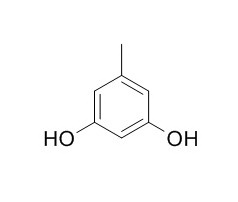Orcinol
Orcinol glucoside is anxiolytic agent without sedative effect, it improves depressive behaviour in CUMS rats by downregulating HPA axis hyperactivity and increasing BDNF expression and ERK1/2 phosphorylation in the hippocampus.
Inquire / Order:
manager@chemfaces.com
Technical Inquiries:
service@chemfaces.com
Tel:
+86-27-84237783
Fax:
+86-27-84254680
Address:
1 Building, No. 83, CheCheng Rd., Wuhan Economic and Technological Development Zone, Wuhan, Hubei 430056, PRC
Providing storage is as stated on the product vial and the vial is kept tightly sealed, the product can be stored for up to
24 months(2-8C).
Wherever possible, you should prepare and use solutions on the same day. However, if you need to make up stock solutions in advance, we recommend that you store the solution as aliquots in tightly sealed vials at -20C. Generally, these will be useable for up to two weeks. Before use, and prior to opening the vial we recommend that you allow your product to equilibrate to room temperature for at least 1 hour.
Need more advice on solubility, usage and handling? Please email to: service@chemfaces.com
The packaging of the product may have turned upside down during transportation, resulting in the natural compounds adhering to the neck or cap of the vial. take the vial out of its packaging and gently shake to let the compounds fall to the bottom of the vial. for liquid products, centrifuge at 200-500 RPM to gather the liquid at the bottom of the vial. try to avoid loss or contamination during handling.
Molecules.2023, 28(18):6734.
Food Bioscience2023, 56:103311.
Int J Mol Sci.2024, 25(19):10660.
Curr Top Med Chem.2020, 20(21):1898-1909.
Analytical methods2019, 11(6)
Neuroscience.2024, 559:77-90.
Food Bioscience2023, 53:102687
Food Chem.2018, 252:207-214
Carbohydrate Polymer Technologies & App.2021, 2:100049.
Appl. Sci.2020, 10(20),7374.
Related and Featured Products
Eur Neuropsychopharmacol. 2014 Jan;24(1):172-80.
Orcinol glucoside produces antidepressant effects by blocking the behavioural and neuronal deficits caused by chronic stress.[Pubmed:
23838013]
This study focused on the antidepressant potential of Orcinol glucoside (OG) and its possible mechanisms of action.
METHODS AND RESULTS:
We established a depressed rat model using 3 consecutive weeks of chronic unpredictable mild stress (CUMS). The antidepressant-like effect of Orcinol glucoside was revealed using the sucrose preference test, the open field test, the forced swimming test (FST), and the tail suspension test (TST). The activity of the hypothalamic-pituitary-adrenal (HPA) axis was evaluated by detecting the serum corticosterone (CORT) concentrations and mRNA expression of corticotrophin-releasing hormone (CRH) in the hypothalamus. The protein expression levels of brain-derived neurotrophic factor (BDNF) and total phosphorylated-ERK1/2 were detected by western blot. The results showed that Orcinol glucoside treatment (1.5, 3, or 6mg/kg) alleviated the depression-like behaviour of rats under CUMS, as indicated by the increased sucrose preference and the decreased immobility in both the FST and TST, although the rearing frequency in the open field test increased only in the group that received the lowest dose (1.5mg/kg OG). Rats that received Orcinol glucoside treatment exhibited reduced serum CORT levels and CRH mRNA expression in the hypothalamus, suggesting that the hyperactivity of the HPA axis in CUMS rats was reversed by Orcinol glucoside treatment. Moreover, Orcinol glucoside treatment upregulated the protein levels of BDNF and phosphorylated-ERK1/2 in the hippocampus, even above control levels.
CONCLUSIONS:
Our findings suggest that Orcinol glucoside improved depressive behaviour in CUMS rats by downregulating HPA axis hyperactivity and increasing BDNF expression and ERK1/2 phosphorylation in the hippocampus.
Pharm Biol. 2015 Jun;53(6):876-81.
Anxiolytic effects of orcinol glucoside and orcinol monohydrate in mice.[Pubmed:
25429891]
Anxiety is a common psychological disorder, often occurring in combination with depression, but therapeutic drugs with high efficacy and safety are lacking. Orcinol glucoside (OG) was recently found to have an antidepressive action. To study the therapeutic potential of Orcinol glucoside and Orcinol monohydrate (OM) as anxiolytic agents.
METHODS AND RESULTS:
Anxiolytic effects in mice were measured using the elevated plus-maze, hole-board, and open-field tests. Eight groups of mice were included in each test. Thirty minutes before each test, mice in each group received one oral administration of Orcinol glucoside (5, 10, or 20 mg/kg), OM (2.5, 5, or 10 mg/kg), the positive control diazepam (1 or 5 mg/kg), or control vehicle. Each mouse underwent only one test. Uptake of Orcinol (5 mg/kg) in the brain was qualitatively detected using the HPLC-MS method. RESULTS: Orcinol glucoside (5, 10, and 20 mg/kg) and OM (2.5 and 5 mg/kg) increased the time spent in open arms and the number of entries into open arms in the elevated plus-maze test. Orcinol glucoside (5 and 10 mg/kg) and OM (2.5 and 5 mg/kg) increased the number of head-dips in the hole-board test. At all tested doses, Orcinol glucoside and OM did not significantly affect the locomotion of mice in the open-field test. Orcinol could be detected in the mouse brain homogenates 30 min after oral OM administration, having confirmed that OM is centrally active.
CONCLUSIONS:
The results demonstrated that Orcinol glucoside and OM are anxiolytic agents without sedative effects, indicating their therapeutic potential for anxiety.



